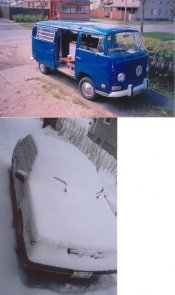Partial rolls
One day I decided to try drinking it black and after about two weeks I thought to myself, "Why would I ever want my coffee any way but black?"
I do exactly what you do. I also have a technique for using two different ISO speeds, and therefore two different development times, on the same roll of film.
First, my main workhorses are a pair of motorized Nikon Fs. The motors have countdown frame counters; when they hit zero, even if there is still film on the spool, they stop. You can manually change the position of the frame counter, but I prefer to get 35 exposures on a roll; fits nicely in my Print File film sleeves and onto one sheet of 8x10 paper. I also put a strip on 1-inch wide masking tape on the back of my camera, with the camera and motor number on it, roll number, film type and ISO rating.
So, let's say that the film in the camera is given its ISO rating for an overcast day, and I have exposed 16 frames; the countdown counter will show 19 frames left. If the sun comes out, and I want to change the development for the conditions I now have, I first note the number of frames exposed, namely 16 (35 - 19 = 16). I then give three blank exposures, and make this note on the masking tape label on the back of the camera: RH 2698 500->16. Underneath it I write: RH 2699 125 20->
RH is my shorthand for camera R, HP5 film, roll 2698 @ ISO 500, with 16 frames exposed at that ISO. The next line is similar, RH for camera and film, but the ISO rating is now 125, starting at frame 20 to the end of the film. Remember, frames 1 to 16 were exposed at ISO 500, frames 17 to 19 are blank, and frames 20 to the end of the roll will be exposed at an ISO of 125. I also adjust the countdown frame counter, setting it backwards by one or two frames, so I use all of the film on the spool; both of these rolls will be shorter than normal, so I might as well use all of the film. When the roll is finished, I rewind and remove the film, and wind the masking tape label around the cassette.
When I get to my darkroom, I use a leader puller to extract the leader from the 35mm cassette. I load my cameras the same each time, so I know that the distance from the end of the film leader to the edge of the first image is 188mm. I also know that from the left edge of the first frame to the left edge of the second frame is 38mm. So, I calculate a length of film to be cut off, which is the first part of the roll, exposed in the example above at ISO 500. In this case, with 16 frames exposed, and three blanks, I make the following calculation: I allow 188mm for the leader, and 16 x 38mm for the first 16 frames, plus 1.5 x 38mm for half of those three blanks I exposed. The total length is 853mm, or about 33 9/16-inches.
I use a large spring paper clip to mark the required length on my work bench, and I have a 100-foot film can and black bag handy. Lights out, and then I pull the film out to the required length, and cut it. I place the length of film into the black bag, and into the film can, and then make sure that I haven't left too much film hanging out of the original cassette. Lights back on, and then I label the cassette and the film can with the necessary information, prior to developing the film.
I have never split a roll into more than two parts, although I suppose it could be done. I prefer this method to loading, unloading and then reloading a roll in the field. If I am covering an event, I find this easier than juggling rolls of film. If you feel that three frames aren't enough, try four or more, as you please.
Chacun a son gout.
I also do this with my 120 film, as well. I use two blank frames, instead of three.
And I also drink my coffee black, and have so for more than 20 years.





